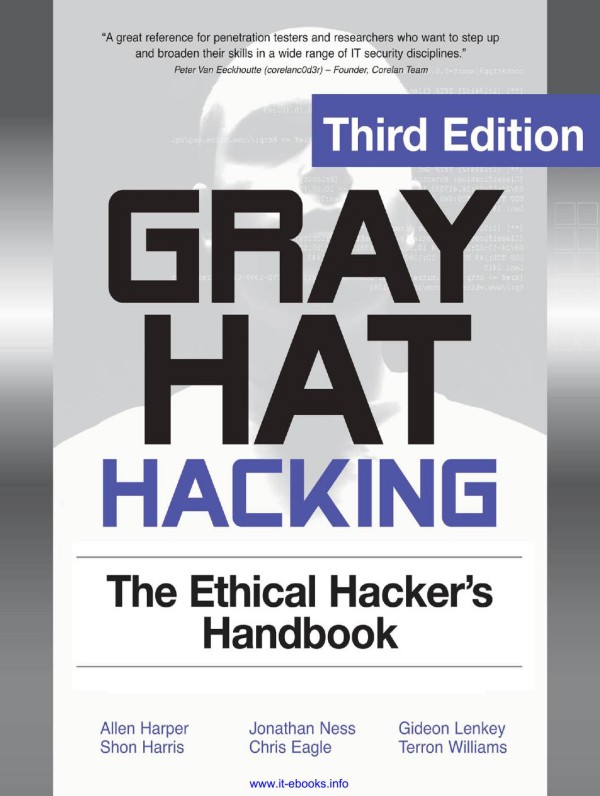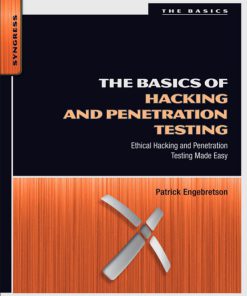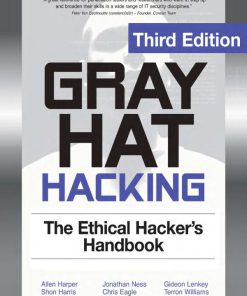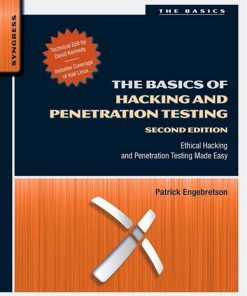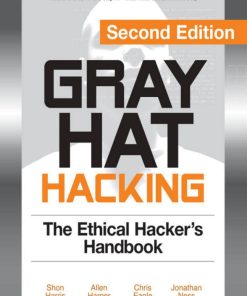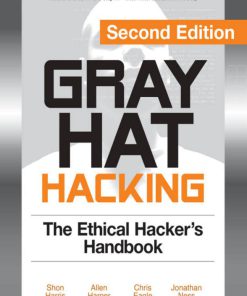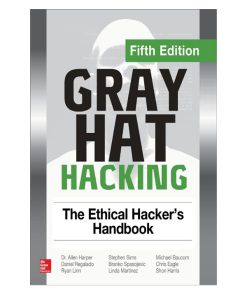Gray Hat Hacking the Ethical Hacker Handbook 3rd Edition by Allen Harper, Shon Harris, Jonathan Ness, Chris Eagle, Gideon Lenkey, Terron Williams ISBN 9780071742566 0071742565
$50.00 Original price was: $50.00.$25.00Current price is: $25.00.
Authors:Allen Harper; Shon Harris; Jonathan Ness; Chris Eagle; Gideon Lenkey; Terron Williams , Series:IT & Computer [236] , Tags:Computers; Security; General , Author sort:Harper, Allen & Harris, Shon & Ness, Jonathan & Eagle, Chris & Lenkey, Gideon & Williams, Terron , Ids:Google; 9780071742566 , Languages:Languages:eng , Published:Published:Feb 2011 , Publisher:McGraw Hill Professional , Comments:Comments:THE LATEST STRATEGIES FOR UNCOVERING TODAY’S MOST DEVASTATING ATTACKS Thwart malicious network intrusion by using cutting-edge techniques for finding and fixing security flaws. Fully updated and expanded with nine new chapters, Gray Hat Hacking: The Ethical Hacker’s Handbook, Third Edition details the most recent vulnerabilities and remedies along with legal disclosure methods. Learn from the experts how hackers target systems, defeat production schemes, write malicious code, and exploit flaws in Windows and Linux systems. Malware analysis, penetration testing, SCADA, VoIP, and Web security are also covered in this comprehensive resource. Develop and launch exploits using BackTrack and Metasploit Employ physical, social engineering, and insider attack techniques Build Perl, Python, and Ruby scripts that initiate stack buffer overflows Understand and prevent malicious content in Adobe, Office, and multimedia files Detect and block client-side, Web server, VoIP, and SCADA attacks Reverse engineer, fuzz, and decompile Windows and Linux software Develop SQL injection, cross-site scripting, and forgery exploits Trap malware and rootkits using honeypots and SandBoxes
Gray Hat Hacking the Ethical Hacker Handbook 3rd Edition by Allen Harper, Shon Harris, Jonathan Ness, Chris Eagle, Gideon Lenkey, Terron Williams – Ebook PDF Instant Download/Delivery. 9780071742566 ,0071742565
Full download Gray Hat Hacking the Ethical Hacker Handbook 3rd Edition after payment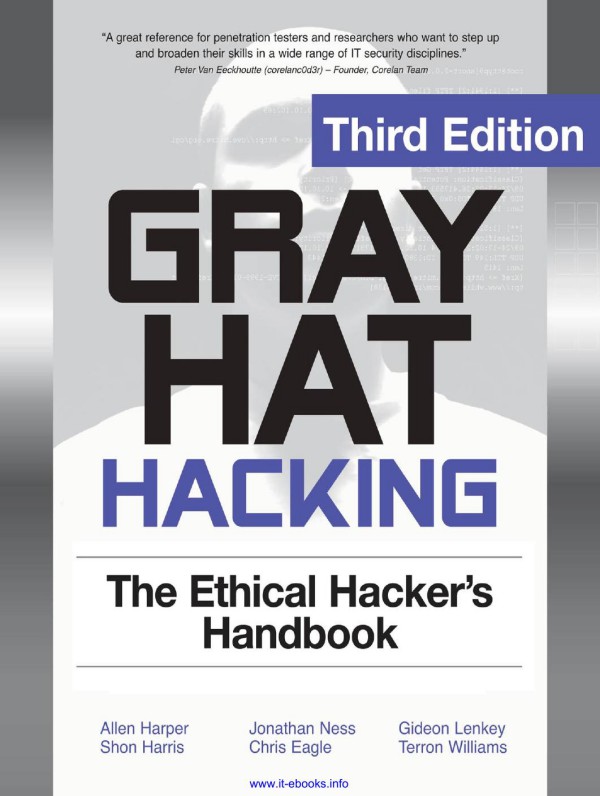
Product details:
ISBN 10: 0071742565
ISBN 13: 9780071742566
Author: Allen Harper, Shon Harris, Jonathan Ness, Chris Eagle, Gideon Lenkey, Terron Williams
Gray Hat Hacking the Ethical Hacker Handbook 3rd Edition Table of contents:
Part I Introduction to Ethical Disclosure
Chapter 1 Ethics of Ethical Hacking
Why You Need to Understand Your Enemy’s Tactics
Recognizing the Gray Areas in Security
How Does This Stuff Relate to an Ethical Hacking Book?
Vulnerability Assessment
Penetration Testing
The Controversy of Hacking Books and Classes
The Dual Nature of Tools
Recognizing Trouble When It Happens
Emulating the Attack
Where Do Attackers Have Most of Their Fun?
Security Does Not Like Complexity
Chapter 2 Ethical Hacking and the Legal System
The Rise of Cyberlaw
Understanding Individual Cyberlaws
18 USC Section 1029: The Access Device Statute
18 USC Section 1030 of the Computer Fraud and Abuse Act
18 USC Sections 2510, et. Seq., and 2701, et. Seq., of the Electronic Communication Privacy Act
Digital Millennium Copyright Act (DMCA)
Cyber Security Enhancement Act of 2002
Securely Protect Yourself Against Cyber Trespass Act (SPY Act)
Chapter 3 Proper and Ethical Disclosure
Different Teams and Points of View
How Did We Get Here?
CERT’s Current Process
Full Disclosure Policy—the RainForest Puppy Policy
Organization for Internet Safety (OIS)
Discovery
Notification
Validation
Resolution
Release
Conflicts Will Still Exist
“No More Free Bugs”
Case Studies
Pros and Cons of Proper Disclosure Processes
Vendors Paying More Attention
So What Should We Do from Here on Out?
iDefense and ZDI
Part II Penetration Testing and Tools
Chapter 4 Social Engineering Attacks
How a Social Engineering Attack Works
Conducting a Social Engineering Attack
Common Attacks Used in Penetration Testing
The Good Samaritan
The Meeting
Join the Company
Preparing Yourself for Face-to-Face Attacks
Defending Against Social Engineering Attacks
Chapter 5 Physical Penetration Attacks
Why a Physical Penetration Is Important
Conducting a Physical Penetration
Reconnaissance
Mental Preparation
Common Ways into a Building
The Smokers’ Door
Manned Checkpoints
Locked Doors
Physically Defeating Locks
Once You Are Inside
Defending Against Physical Penetrations
Chapter 6 Insider Attacks
Why Simulating an Insider Attack Is Important
Conducting an Insider Attack
Tools and Preparation
Orientation
Gaining Local Administrator Privileges
Disabling Antivirus
Raising Cain
Defending Against Insider Attacks
Chapter 7 Using the BackTrack Linux Distribution
BackTrack: The Big Picture
Installing BackTrack to DVD or USB Thumb Drive
Using the BackTrack ISO Directly Within a Virtual Machine
Creating a BackTrack Virtual Machine with VirtualBox
Booting the BackTrack LiveDVD System
Exploring the BackTrack X Windows Environment
Starting Network Services
Persisting Changes to Your BackTrack Installation
Installing Full BackTrack to Hard Drive or USB Thumb Drive
Creating a New ISO with Your One-time Changes
Using a Custom File that Automatically Saves and Restores Changes
Exploring the BackTrack Boot Menu
Updating BackTrack
Chapter 8 Using Metasploit
Metasploit: The Big Picture
Getting Metasploit
Using the Metasploit Console to Launch Exploits
Exploiting Client-Side Vulnerabilities with Metasploit
Penetration Testing with Metasploit’s Meterpreter
Automating and Scripting Metasploit
Going Further with Metasploit
Chapter 9 Managing a Penetration Test
Planning a Penetration Test
Types of Penetration Tests
Scope of a Penetration Test
Locations of the Penetration Test
Organization of the Penetration Testing Team
Methodologies and Standards
Phases of the Penetration Test
Testing Plan for a Penetration Test
Structuring a Penetration Testing Agreement
Statement of Work
Get-Out-of-Jail-Free Letter
Execution of a Penetration Test
Kickoff Meeting
Access During the Penetration Test
Managing Expectations
Managing Problems
Steady Is Fast
External and Internal Coordination
Information Sharing During a Penetration Test
Dradis Server
Reporting the Results of a Penetration Test
Format of the Report
Out Brief of the Report
Part III Exploiting
Chapter 10 Programming Survival Skills
C Programming Language
Basic C Language Constructs
Sample Program
Compiling with gcc
Computer Memory
Random Access Memory (RAM)
Endian
Segmentation of Memory
Programs in Memory
Buffers
Strings in Memory
Pointers
Putting the Pieces of Memory Together
Intel Processors
Registers
Assembly Language Basics
Machine vs. Assembly vs C
AT&T vs. NASM
Addressing Modes
Assembly File Structure
Assembling
Debugging with gdb
gdb Basics
Disassembly with gdb
Python Survival Skills
Getting Python
Hello World in Python
Python Objects
Strings
Numbers
Lists
Dictionaries
Files with Python
Sockets with Python
Chapter 11 Basic Linux Exploits
Stack Operations
Function Calling Procedure
Buffer Overflows
Overflow of meet.c
Ramifications of Buffer Overflows
Local Buffer Overflow Exploits
Components of the Exploit
Exploiting Stack Overflows from the Command Line
Exploiting Stack Overflows with Generic Exploit Code
Exploiting Small Buffers
Exploit Development Process
Control eip
Determine the Offset(s)
Determine the Attack Vector
Build the Exploit Sandwich
Test the Exploit
Chapter 12 Advanced Linux Exploits
Format String Exploits
The Problem
Reading from Arbitrary Memory
Writing to Arbitrary Memory
Taking dtors to root
Memory Protection Schemes
Compiler Improvements
Kernel Patches and Scripts
Return to libc Exploits
Bottom Line
Chapter 13 Shellcode Strategies
User Space Shellcode
System Calls
Basic Shellcode
Port Binding Shellcode
Reverse Shellcode
Find Socket Shellcode
Command Execution Code
File Transfer Code
Multistage Shellcode
System Call Proxy Shellcode
Process Injection Shellcode
Other Shellcode Considerations
Shellcode Encoding
Self-Corrupting Shellcode
Disassembling Shellcode
Kernel Space Shellcode
Kernel Space Considerations
Chapter 14 Writing Linux Shellcode
Basic Linux Shellcode
System Calls
System Calls by C
System Calls by Assembly
Exit System Call
setreuid System Call
Shell-Spawning Shellcode with execve
Implementing Port-Binding Shellcode
Linux Socket Programming
Assembly Program to Establish a Socket
Test the Shellcode
Implementing Reverse Connecting Shellcode
Reverse Connecting C Program
Reverse Connecting Assembly Program
Encoding Shellcode
Simple XOR Encoding
Structure of Encoded Shellcode
JMP/CALL XOR Decoder Example
FNSTENV XOR Example
Putting the Code Together
Automating Shellcode Generation with Metasploit
Generating Shellcode with Metasploit
Encoding Shellcode with Metasploit
Chapter 15 Windows Exploits
Compiling and Debugging Windows Programs
Compiling on Windows
Debugging on Windows with OllyDbg
Writing Windows Exploits
Exploit Development Process Review
ProSSHD Server
Control eip
Determine the Offset(s)
Determine the Attack Vector
Build the Exploit Sandwich
Debug the Exploit if Needed
Understanding Structured Exception Handling (SEH)
Implementation of SEH
Understanding Windows Memory Protections (XP SP3, Vista, 7, and Server 2008)
Stack-Based Buffer Overrun Detection (/GS)
Safe Structured Exception Handling (SafeSEH)
SEH Overwrite Protection (SEHOP)
Heap Protections
Data Execution Prevention (DEP)
Address Space Layout Randomization (ASLR)
Bypassing Windows Memory Protections
Bypassing /GS
Bypassing SafeSEH
Bypassing ASLR
Bypassing DEP
Bypassing SEHOP
Summary of Memory Bypass Methods
Chapter 16 Understanding and Detecting Content-Type Attacks
How Do Content-Type Attacks Work?
Which File Formats Are Being Exploited Today?
Intro to the PDF File Format
Analyzing a Malicious PDF Exploit
Implementing Safeguards in Your Analysis Environment
Tools to Detect Malicious PDF Files
PDFiD
pdf-parserpy
Tools to Test Your Protections Against Content-type Attacks
How to Protect Your Environment from Content-type Attacks
Apply All Security Updates
Disable JavaScript in Adobe Reader
Enable DEP for Microsoft Office Application and Adobe Reader
Chapter 17 Web Application Security Vulnerabilities
Overview of Top Web Application Security Vulnerabilities
Injection Vulnerabilities
Cross-Site Scripting Vulnerabilities
The Rest of the OWASP Top Ten
SQL Injection Vulnerabilities
SQL Databases and Statements
Testing Web Applications to Find SQL Injection Vulnerabilities
Cross-Site Scripting Vulnerabilities
Explaining “Scripting”
Explaining Cross-Site Scripting
Chapter 18 VoIP Attacks
What Is VoIP?
Protocols Used by VoIP
SIP
Megaco H.248
H.323
TLS and DTLS
SRTP
ZRTP
Types of VoIP Attacks
Enumeration
SIP Password Cracking
Eavesdropping/Packet Capture
Denial of Service
How to Protect Against VoIP Attacks
Chapter 19 SCADA Attacks
What Is SCADA?
Which Protocols Does SCADA Use?
OPC
ICCP
Modbus
DNP3
SCADA Fuzzing
SCADA Fuzzing with Autodafé
SCADA Fuzzing with TFTP Daemon Fuzzer
Stuxnet Malware (The New Wave in Cyberterrorism)
How to Protect Against SCADA Attacks
Part IV Vulnerability Analysis
Chapter 20 Passive Analysis
Ethical Reverse Engineering
Why Bother with Reverse Engineering?
Reverse Engineering Considerations
Source Code Analysis
Source Code Auditing Tools
The Utility of Source Code Auditing Tools
Manual Source Code Auditing
Automated Source Code Analysis
Binary Analysis
Manual Auditing of Binary Code
Automated Binary Analysis Tools
Chapter 21 Advanced Static Analysis with IDA Pro
Static Analysis Challenges
Stripped Binaries
Statically Linked Programs and FLAIR
Data Structure Analysis
Quirks of Compiled C++ Code
Extending IDA Pro
Scripting with IDC
IDA Pro Plug-In Modules and the IDA Pro SDK
Building IDA Pro Plug-Ins
IDA Pro Loaders and Processor Modules
Chapter 22 Advanced Reverse Engineering
Why Try to Break Software?
Overview of the Software Development Process
Instrumentation Tools
Debuggers
Code Coverage Analysis Tools
Profiling Tools
Flow Analysis Tools
Memory Use Monitoring Tools
Fuzzing
Instrumented Fuzzing Tools and Techniques
A Simple URL Fuzzer
Fuzzing Unknown Protocols
SPIKE
SPIKE Static Content Primitives
SPIKE Proxy
Sharefuzz
Chapter 23 Client-Side Browser Exploits
Why Client-Side Vulnerabilities Are Interesting
Client-Side Vulnerabilities Bypass Firewall Protections
Client-Side Applications Are Often Running with Administrative Privileges
Client-Side Vulnerabilities Can Easily Target Specific People or Organizations
Internet Explorer Security Concepts
ActiveX Controls
Internet Explorer Security Zones
History of Client-Side Exploits and Latest Trends
Client-Side Vulnerabilities Rise to Prominence
Notable Vulnerabilities in the History of Client-Side Attacks
Finding New Browser-Based Vulnerabilities
mangleme
Mozilla Security Team Fuzzers
AxEnum
AxFuzz
AxMan
Heap Spray to Exploit
InternetExploiter
Protecting Yourself from Client-Side Exploits
Keep Up-to-Date on Security Patches
Stay Informed
Run Internet-Facing Applications with Reduced Privileges
Chapter 24 Exploiting the Windows Access Control Model
Why Access Control Is Interesting to a Hacker
Most People Don’t Understand Access Control
Vulnerabilities You Find Are Easy to Exploit
You’ll Find Tons of Security Vulnerabilities
How Windows Access Control Works
Security Identifier
Access Token
Security Descriptor
The Access Check
Tools for Analyzing Access Control Configurations
Dumping the Process Token
Dumping the Security Descriptor
Special SIDs, Special Access, and “Access Denied”
Special SIDs
Special Access
Investigating “Access Denied”
Analyzing Access Control for Elevation of Privilege
Attack Patterns for Each Interesting Object Type
Attacking Services
Attacking Weak DACLs in the Windows Registry
Attacking Weak Directory DACLs
Attacking Weak File DACLs
What Other Object Types Are Out There?
Enumerating Shared Memory Sections
Enumerating Named Pipes
Enumerating Processes
Enumerating Other Named Kernel Objects (Semaphores, Mutexes, Events, Devices)
Chapter 25 Intelligent Fuzzing with Sulley
Protocol Analysis
Sulley Fuzzing Framework
Installing Sulley
Powerful Fuzzer
Blocks
Monitoring the Process for Faults
Monitoring the Network Traffic
Controlling VMware
Putting It All Together
Postmortem Analysis of Crashes
Analysis of Network Traffic
Exploring Further
Chapter 26 From Vulnerability to Exploit
Exploitability
Debugging for Exploitation
Initial Analysis
Understanding the Problem
Preconditions and Postconditions
Repeatability
Payload Construction Considerations
Payload Protocol Elements
Buffer Orientation Problems
Self-Destructive Shellcode
Documenting the Problem
Background Information
Circumstances
Research Results
Chapter 27 Closing the Holes: Mitigation
Mitigation Alternatives
Port Knocking
Migration
Patching
Source Code Patching Considerations
Binary Patching Considerations
Binary Mutation
Third-Party Patching Initiatives
Part V Malware Analysis
Chapter 28 Collecting Malware and Initial Analysis
Malware
Types of Malware
Malware Defensive Techniques
Latest Trends in Honeynet Technology
Honeypots
Honeynets
Why Honeypots Are Used
Limitations of Honeypots
Low-Interaction Honeypots
High-Interaction Honeypots
Types of Honeynets
Thwarting VMware Detection Technologies
Catching Malware: Setting the Trap
VMware Host Setup
VMware Guest Setup
Using Nepenthes to Catch a Fly
Initial Analysis of Malware
Static Analysis
Live Analysis
Norman SandBox Technology
Chapter 29 Hacking Malware
Trends in Malware
Embedded Components
Use of Encryption
User Space Hiding Techniques
Use of Rootkit Technology
Persistence Measures
De-obfuscating Malware
Packer Basics
Unpacking Binaries
Reverse-Engineering Malware
Malware Setup Phase
Malware Operation Phase
Automated Malware Analysis
Index
People also search for Gray Hat Hacking the Ethical Hacker Handbook 3rd Edition:
gray hat hacking the ethical hacker’s handbook 3rd edition
is grey hat hacking ethical
grey hat hacker vs black hat hacker
difference between grey hat hackers and black hat hackers
You may also like…
eBook PDF
The Ghidra Book The Definitive Guide 1st edition by Chris Eagle, Kara Nance 9781718501034 171850103X

